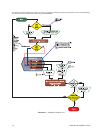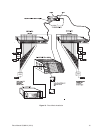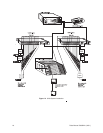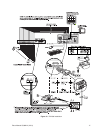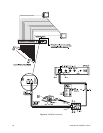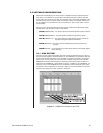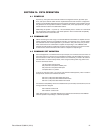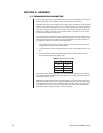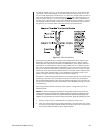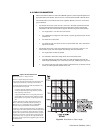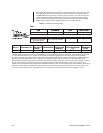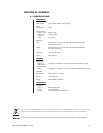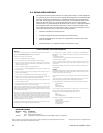
26 Pelco Manual C539M-A (12/01)
Although the communication link can be as far away as 4,000 feet (1,220 m) (per Figure 20),
this is theoretical. Pelco recommends that for distances greater than 2,000 feet (610 m)
a CM9505UPS-422 power supply, with data repeater, be used. In any case, Pelco recom-
mends using a cable similar to Belden 9843 that meets or exceeds the support require-
ments for TIA/EIA-422 applications. Table C is taken directly from the FULL TECHNICAL
SPECS page in Belden’s Cable Catalog located on their company web site.
Table C. (TIA/EIA-422) Cable Example
9843
AWG STRANDED TYPE INSULATION
24 (7 x 32) TC – Tinned Copper PE – Polyethylene
SHIELD JACKET # PAIR # TRIADS
Aluminum Foil-Polyester PVC – Polyvinyl Chloride 3 0
Tape/Braid Shield
NOMINAL INSULATION JACKET NOMINAL NOMINAL NOMINAL VELOCITY NOMINAL
OD (in.) THICKNESS (in.) THICKNESS CAPACITANCE CONDUCTOR OF PROPAGATION IMPEDANCE
(Pf/FT) DCR (/M') (%) (ohms)
.3600 .00000 .0000 12.800 24.000 66.0 120.0
* TIA/EIA-422-B is the full name of the current standard for what is commonly referred to as RS-422. The prefix “RS”, which stands
for “recommended standard”, was used by the EIA (Electronic Industries Association) as the name for some of its standards.
The “RS-” prefix was dropped by the EIA in 1986 and standards were simply referred to with the EIA- prefix. In 1988 TIA (Telecom-
munication Industries Association) was a working group of the EIA and the reference evolved to a combined EIA/TIA- prefix.
When TIA became ANSI (American National Standards Institute) accredited, the acronym order was reversed to TIA/EIA-. In 1992
TIA spun off from EIA and merged with US Telecommunications Suppliers Association (USTSA). From about that time to the
present, the full standard has been referenced as ANSI/TIA/EIA-422-B, where “B” is the latest revision of the standard. Normally the
standard is written simply as TIA/EIA-422. In all probability, that will be shortened to just TIA-422 at some point in the future. How-
ever, everyone has used the “RS-” prefix reference for so long that it may be some time before its use disappears, if at all.




